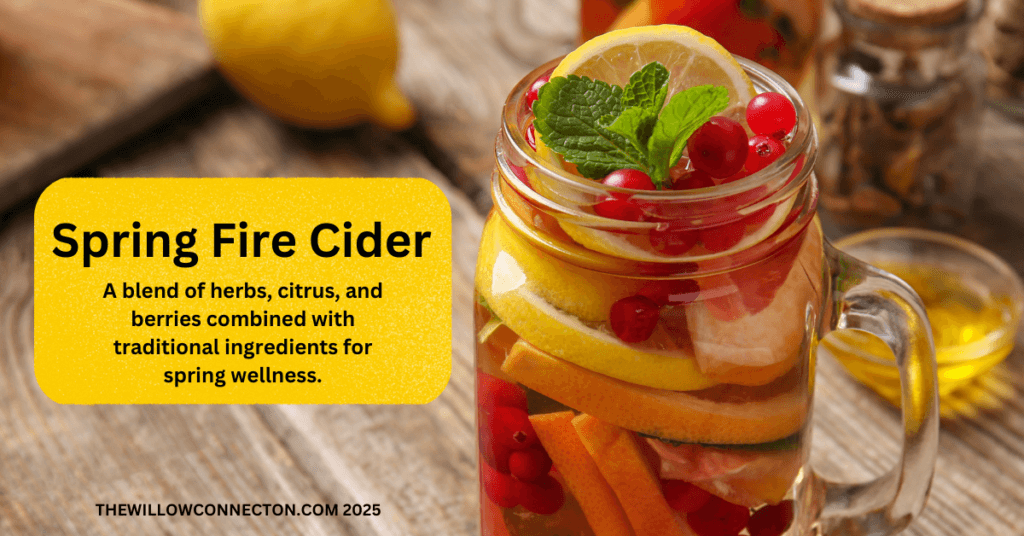Fire Cider: A Spicy Remedy for Year-round Wellness
Fire cider is a traditional folk remedy that has been used for centuries to boost immunity and support overall health especially during the colder months. This medicinal-like concoction is typically made by infusing apple cider vinegar with a variety of warming herbs and spices. There are variations to this recipe, and it can be modified based on your use or tastebuds. The recipes below are not mine, but I have made them myself.
Benefits of Fire Cider:
- Boosts Immunity: The combination of antiviral herbs like horseradish, garlic, and onion, along with immune-supporting ingredients like ginger and turmeric, can help strengthen your body’s defenses against colds and flu.
- Soothes Sore Throats: The anti-inflammatory properties of honey and the antibacterial action of apple cider vinegar can help soothe sore throats and ease congestion.
- Aids Digestion: Ginger and turmeric can help improve digestion and reduce bloating and gas.
- Relieves Cold Symptoms: The warming properties of ginger, cayenne pepper, and horseradish can help loosen congestion and clear sinuses.
- Provides Antioxidants: Many of the herbs and spices in fire cider are rich in antioxidants, which can help protect your cells from damage.
How to Use Fire Cider:
- As a Daily Tonic: Add 1-2 tablespoons of fire cider to a glass of water and drink it daily as a preventative measure, especially during cold and flu season.
- To Soothe a Sore Throat: Gargle with a diluted solution of fire cider and water several times a day.
- To Relieve Cold Symptoms: Add a teaspoon of fire cider to hot water with a squeeze of lemon and honey for a soothing and immune-boosting beverage.
- In Salad Dressings: Add a dash of fire cider to your favorite salad dressing for an extra kick of flavor and health benefits.
Making Your Own Traditional Fire Cider:
Ingredients:
- 1 quart apple cider vinegar or enough to fill jar
- 1 large onion, sliced
- 4-5 cloves garlic, sliced
- 1-inch fresh ginger, sliced
- 1/4 cup horseradish root, grated
- 1/4 cup turmeric root, grated
- 1-2 jalapeños or habanero peppers, sliced (optional)
- 1 tablespoon grated fresh horseradish root
- 1 tablespoon cayenne pepper
- 1 tablespoon honey
Instructions:
- Combine all ingredients in a glass jar.
- Seal tightly and give it a shake.
- Store in a cool, dark place for at least 4 weeks, shaking occasionally.
- Strain the mixture through a fine-mesh sieve or cheesecloth.
- Store the fire cider in a glass bottle in the refrigerator or away from sunlight.
Important Notes:
- It is not necessary to dilute fire cider if you like the taste.
- If you have any underlying health conditions or are pregnant or breastfeeding, consult with a healthcare professional before using fire cider.
- Storing fire cider in the refrigerator may prevent spoilage. I have had my current batch of citrusy fire cider on the counter for over a year with no evidence of spoilage.
Fire cider is a delicious and versatile remedy that can be enjoyed throughout the year. By incorporating it into your wellness routine, you can support your immune system and stay healthy all year long.
Citrusy Fire Cider
This recipe isn’t just for spring and summer use, but its flavor profile is light and tangy making it a great option for the warmer months of the year. If you make your batch in the spring, you will have it ready to use by the time the weather gets warmer.
- 1 handful of pine needles (they have a citrusy flavor)
- 12-ounce bag of cranberries, rinsed
- 3 cinnamon sticks
- 4 mandarin oranges or 1-2 navel, washed and sliced
- 1–2 lemons, washed and sliced
- 1 lime, washed and sliced (optional)
- 1 whole ginger root, washed and sliced into discs
- 2 teaspoons of course ground black pepper
- ½ cup raw honey, local is best
- Apple cider vinegar (enough to fill the jar)
Instructions:
Follow instructions for above traditional fire cider. I put the pine needles in first pushing them up against the glass making room for the remaining ingredients.
This fire cider has a favorable zing to it making it a great base to create your own vinaigrette for spring and summer salads or drizzles on fish and poultry dishes.
Educate yourself on the pine trees you are harvesting from. While many varieties are safe, pine such as Yew, Ponderosa, Lodgepole, and Norfolk should be avoided.
Disclaimer: This information is for educational purposes only and should not be considered medical advice. Always consult with a healthcare professional before making any changes to your diet or health regimen.





